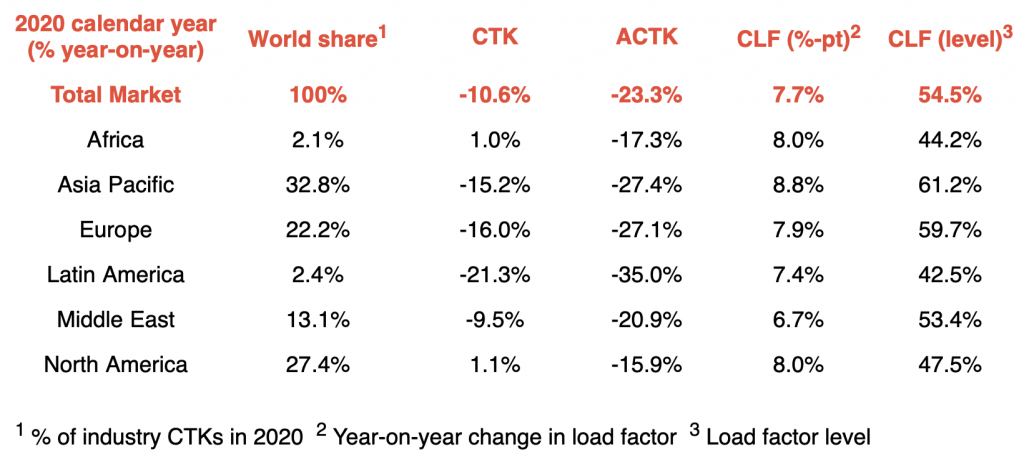
IATA data shows that global airfreight market demand decreased by 10.6% in 2020, compared to 2019.
This was the largest drop in year-on-year demand since IATA started to monitor cargo performance in 1990, outpacing the 6% fall in global trade in goods.
Global demand in 2020, measured in cargo tonne-kilometers (CTKs*), was 10.6% below 2019 levels (-11.8% for international operations).
Global capacity, measured in available cargo tonne-kilometers (ACTKs), shrank by 23.3% in 2020 ( 24.1% for international operations) compared to 2019. This was more than double the contraction in demand.
Due to the lack of available capacity, cargo load factors rose 7.7% in 2020. This contributed to increased yields and revenues, providing support to airlines and some long-haul passenger services in the face of collapsed passenger revenues.
Improvements towards yearend were demonstrated in December when global demand was 0.5% below previous-year levels (-2.3% for international operations). Global capacity was 17.7% below previous-year levels (‑20.6% for international operations).
That is much deeper than the contraction in demand, indicating the continuing and severe capacity crunch. With the stalling of the recovery in passenger markets, there is no end in sight for the capacity crunch.
Economic conditions are picking up as we move into 2021. The new export orders component of the manufacturing Purchasing Managers’ Index (PMI)¹ is in growth territory in both developed and emerging markets. And global industrial production has also recovered.
“Air cargo is surviving the crisis in better shape than the passenger side of the business. For many airlines, 2020 saw air cargo become a vital source of revenues, despite weakened demand. But with much of the passenger fleet grounded, meeting demand without belly capacity continues to be an enormous challenge.
“And, as countries strengthen travel restrictions in the face of new coronavirus variants, it is difficult to see improvements in passenger demand or the capacity crunch. 2021 will be another tough year,” said Alexandre de Juniac, IATA’s Director General and CEO.
2020 Regional Performance
Strong variations were evident in the regional performance of air cargo in 2020. North American and African carriers reported an annual gain in demand in 2020 (+1.1% and +1.0%, respectively), while all other regions remained in negative territory compared to 2019. International demand fell in all regions with the exception of Africa which posted a 1.9% increase in 2020 compared to the previous year.
Asia-Pacific airlines reported a decline in demand of 15.2% in 2020 compared to 2019 (-13.2% for international operations) and a fall in capacity of 27.4% (-26.2% for international operations).
In December airlines in the region posted a 3.9% decrease in international demand compared to the previous year. After a pause in recovery in Q3, demand is improving, driven by a rebound in manufacturing activity and export orders from China and South Korea. International capacity remained constrained in December, down 25.1%.
North American carriers posted a 1.1% increase in demand in 2020 compared to 2019 (-5.2% for international operations) and a fall in capacity of 15.9% (-19.7% for international operations). In December carriers in the region posted an increase of 3.1% in international demand.
This was the strongest monthly performance since late 2018. Strong traffic on the Asia-North America routes, which was up 2.1% in 2020, contributed to the performance, driven by strong demand from North American consumers for goods manufactured in Asia. Capacity remained constrained, down 14.1% in December.
European carriers reported a 16.0% drop in demand in 2020 compared to 2019 (-16.2% for international operations) and a fall in capacity of 27.1% (-27.1% for international operations). In December airlines posted a decrease in international demand of 5.6% compared to the previous year.
After a pause in recovery in November, seasonally adjusted demand grew 7% month-on-month in December, the largest rise of all regions. However, new lockdowns and adverse economic conditions in the region risk the recovery. Lack of capacity remains a challenge, as international capacity decreased 19.4% in December.
Middle Eastern carriers reported a decline in demand of 9.5% in 2020 compared to 2019 (-9.5% for international operations) and a fall in capacity of 20.9% (-20.6% for international operations).
After a slight slowdown in recovery in November, carriers in the region performed well in December, posting a 2.3% increase in international demand. International capacity decreased by 18.2% in December, unchanged from November.
Latin American carriers reported a decline in demand of 21.3% in 2020 compared to 2019 (-20.3% for international operations) and a fall in capacity of 35% (-33.6% for international operations). In December international cargo volumes fell by 19.0% compared to the previous year.
Air cargo recovery in the region has been affected by adverse economic conditions in markets such as Mexico, Argentina and Peru. Capacity remains highly constraint in the region. International capacity decreased in December by 36.7%, a steepening of the 30.4% fall in November.
African airlines saw demand grow by 1.0% in 2020 compared to 2019 (1.9% for international operations) and a fall in capacity of 17.3% (-15.8% for international operations).
African airlines posted the strongest international growth of all regions in 2020 as well as in December. International demand in the month grew by 6.3% year-on-year. African airlines now have the same share of the global international cargo market as carriers from Latin America (2.4%). International capacity decreased by 21.6% in December, a steepening of the 18.6% fall in November.

